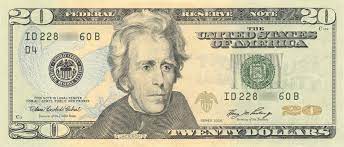On September 24, 1998, the United States unveiled a new design for its $20 bills, featuring enhanced security features and a fresh aesthetic. This redesign aimed to combat counterfeiting and modernize the appearance of one of the most widely circulated banknotes in the country. The new $20 bill design was the result of years of research and development by the U.S. Department of the Treasury and the Federal Reserve. The primary goal was to introduce advanced security features that would make it more difficult for counterfeiters to replicate the bill. One of the most notable changes was the inclusion of a watermark, commonly known as the "watermark portrait." This portrait, visible when held up to light, is a faint image of President Andrew Jackson, the historical figure depicted on the $20 bill. This feature added an additional layer of security, as it was difficult to reproduce accurately. Another significant security feature was the introduction of a security thread embedded in the bill. This thin strip, visible when held up to light, contained microprinting of the denomination "USA TWENTY" and a small flag. This thread made it harder for counterfeiters to create convincing replicas of the bill. Additionally, the new $20 bill incorporated color-shifting ink. The number "20" on the lower right-hand corner of the bill changed color from copper to green when tilted, providing a visible indication of authenticity. The redesign also brought aesthetic changes to the bill. The portrait of President Andrew Jackson was slightly modified, featuring a larger and more detailed image. The background of the bill was given a more intricate design, incorporating patterns and textures inspired by the era of Jackson's presidency. The release of the new $20 bills was met with mixed reactions. Some praised the enhanced security features, believing they would effectively deter counterfeiting. Others appreciated the updated design, which brought a modern touch to the currency. However, there were also critics who argued that the redesign was unnecessary and merely a cosmetic change. Regardless of the differing opinions, the introduction of the new $20 bills had a significant impact on the circulation of currency in the United States. The enhanced security features helped to reduce the prevalence of counterfeit bills and protect the integrity of the U.S. currency system. The redesign of the $20 bill in 1998 was part of an ongoing effort by the U.S. government to stay ahead of counterfeiters and maintain the trust of the public in its currency. It demonstrated a commitment to utilizing advanced technology and design to safeguard the economy and financial transactions. Since the initial redesign in 1998, the U.S. government has continued to update and enhance the security features of its banknotes. These ongoing efforts reflect the evolving nature of counterfeiting and the need for constant innovation to combat fraudulent activities. The new $20 bills introduced on September 24, 1998, marked an important milestone in the history of U.S. currency. With their enhanced security features and updated design, they represented a significant step forward in the fight against counterfeiting and the preservation of the integrity of the U.S. dollar.
24 Sept, 1998 U.S.A. New $20 Bills
